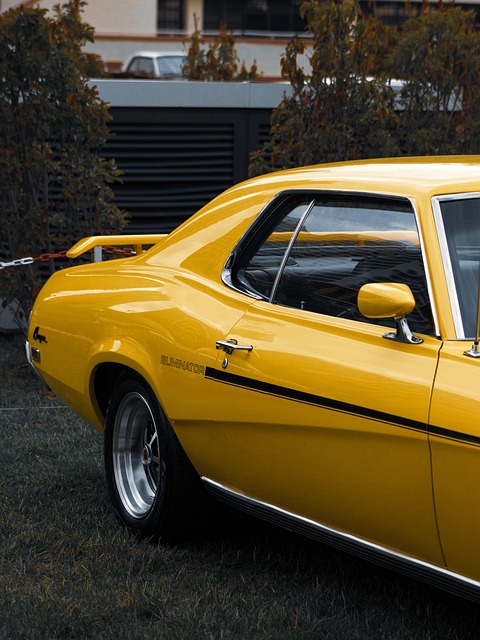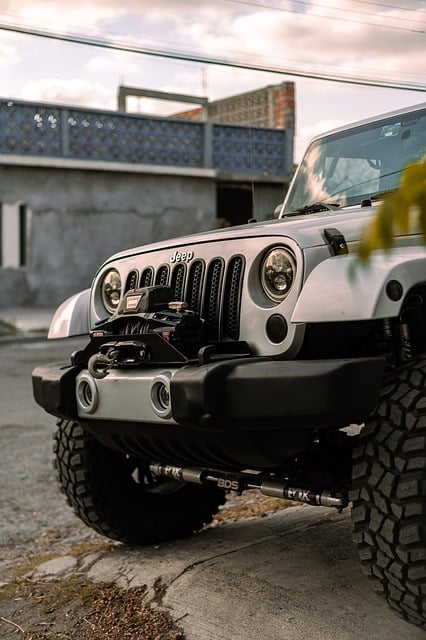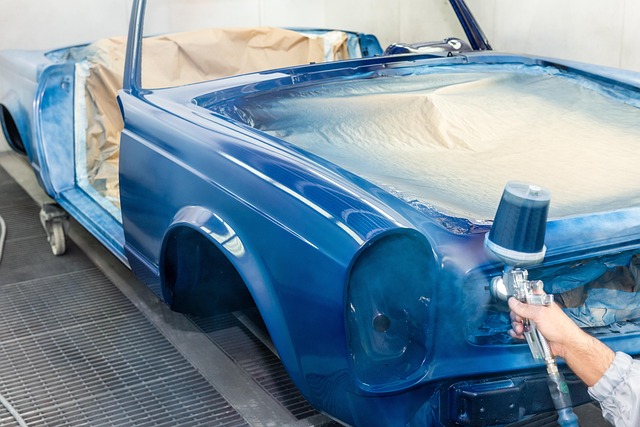Efficient Loaner Vehicle Collision Repair for Classics and Vintage Cars
In automotive collision repair for classic and vintage cars, loaner vehicles are crucial for maintai…….
In the dynamic world of automotive services, loaner vehicle collision repair stands as a cornerstone of efficient and customer-centric damage restoration. This process involves providing temporary replacement vehicles to clients while their damaged cars undergo intricate repair work, ensuring minimal disruption in their daily lives. As the global automotive industry continues its relentless march towards innovation and sustainability, understanding and optimizing loaner vehicle collision repair processes have become more critical than ever.
This comprehensive article aims to dissect this multifaceted practice, exploring its historical roots, current global impact, economic implications, technological innovations, regulatory landscape, challenges, and future prospects. By delving into these aspects, we will provide valuable insights for industry stakeholders, policymakers, and enthusiasts alike.
Definition: Loaner vehicle collision repair refers to a service offered by automotive repair facilities or insurance companies where clients are provided with a temporary, often identical or similar make and model vehicle while their damaged car is being repaired. This practice ensures continuity in transportation needs without the client having to endure extended periods without their primary vehicle.
Core Components:
Damage Assessment: The process begins with a thorough inspection of both the damaged vehicle and the desired loaner car to ensure compatibility in terms of size, safety features, and overall condition.
Insurance Collaboration: In most cases, insurance companies play a pivotal role in facilitating the loaner vehicle arrangement as part of their post-collision repair support to policyholders. They coordinate with repair shops to ensure a seamless transition.
Repair and Restoration: While the damaged car undergoes intricate repairs, ranging from cosmetic to structural, the loaner vehicle serves as a temporary replacement, allowing clients to maintain their regular routines.
Handover and Return: Once the repairs are complete, the client receives back their restored vehicle, and the loaner is either returned to the facility or released to another customer, ensuring continuous availability for all users.
Historical Context: The concept of loaner vehicles has its roots in traditional automotive service practices, where repair shops offered temporary cars to customers awaiting lengthy repairs. However, it gained significant traction in the late 20th century as insurance companies began incorporating it into their collision repair processes, formalizing the system and enhancing customer satisfaction.
Loaner vehicle collision repair has transcended geographical boundaries, becoming an integral part of automotive service ecosystems worldwide. Its impact and trends vary across regions, reflecting local markets, cultural preferences, and regulatory environments.
The United States and Canada have long been recognized as pioneers in adopting and refining loaner vehicle services. The region’s robust automotive industry and advanced insurance systems have contributed to a highly sophisticated network of providers. Here are some key trends:
Regional Focus: Major metropolitan areas like Los Angeles, New York, and Toronto have seen specialized loaner vehicle companies emerge, catering to the diverse needs of their bustling cities.
Technology Integration: North American providers are leveraging digital platforms for efficient inventory management, real-time availability checks, and seamless booking processes, enhancing customer experience.
Sustainability Push: There is a growing emphasis on eco-friendly loaner vehicle options, with electric and hybrid models gaining popularity to align with the region’s environmental initiatives.
Europe presents a diverse landscape when it comes to loaner vehicle practices, with each country having its unique approach.
German Precision: Germany, renowned for its automotive engineering, has a robust system of loaner vehicles, often featuring high-quality, European-made cars, reflecting the country’s commitment to precision and customer satisfaction.
UK Flexibility: The United Kingdom takes a more diverse approach, offering a mix of brand-new and pre-owned loaner vehicles, catering to various budget and preference considerations.
Environmental Focus: Many European countries are pushing for sustainable practices by encouraging the use of electric vehicles as loaners, contributing to their overall environmental goals.
The Asia Pacific region, encompassing China, Japan, South Korea, and Southeast Asian nations, is witnessing explosive growth in the automotive sector, directly impacting loaner vehicle collision repair.
Chinese Innovation: China, with its massive automotive market, has seen a surge in specialized loaner vehicle companies, offering a vast array of options to cater to its diverse customer base.
Japanese Efficiency: Japan’s traditional focus on quality and efficiency translates into streamlined loaner vehicle services, often featuring the latest models from domestic car manufacturers.
Cultural Considerations: In many Asian countries, loaner vehicles are chosen with cultural preferences in mind, offering a range of local and international brands to suit diverse tastes.
The economic aspects of loaner vehicle collision repair are intricate, involving market forces, consumer behavior, and strategic investments.
Demand Drivers: The primary demand for loaner vehicles stems from insurance claims following vehicle accidents or damage due to natural disasters. Urbanization and the growing number of vehicles on the road further propel this demand.
Supplier Ecosystem: A robust network of suppliers, including automotive manufacturers, rental car companies, and specialized loaner vehicle dealers, is essential for ensuring a steady supply of vehicles to repair facilities.
Pricing Strategies: Repair shops and insurance companies employ various pricing models, from hourly rates to fixed prices per day or week, depending on local practices and competition.
Capital Expenditure (CapEx): Repair facilities invest heavily in CapEx for acquiring loaner vehicles, often requiring significant funding to build a diverse and up-to-date fleet.
Operational Expenditure (OpEx): Ongoing costs include maintenance, insurance, and administrative expenses associated with managing the loaner vehicle program. Efficient inventory management is key to controlling these costs.
Strategic Partnerships: Many companies partner with automotive manufacturers or rental car companies to secure favorable terms, access to new models, and cost savings.
Technology plays a pivotal role in modernizing loaner vehicle collision repair, enhancing efficiency, and improving customer experiences.
Online Booking Platforms: Customers can now easily reserve loaner vehicles through user-friendly digital platforms, allowing real-time availability checks and seamless booking processes.
GPS Tracking: This technology enables repair shops to locate and manage their loaner vehicle fleets efficiently, ensuring prompt handovers and returns.
Digital Inventory Management: Digital systems streamline inventory tracking, making it easier to monitor vehicle conditions, maintenance schedules, and usage patterns.
Connected Cars: IoT enables vehicles to communicate their status, enabling repair shops to remotely diagnose issues and plan repairs, reducing downtime for both customers and service providers.
Predictive Analytics: By analyzing data from sensors and past repair records, predictive models can anticipate maintenance needs, helping to keep loaner vehicles in top condition.
Remote Monitoring: IoT devices allow for remote monitoring of vehicle performance, enabling quick responses to issues and enhancing overall fleet management.
Pre-Repair Visualization: VR and AR technologies can be used to visually guide clients through potential repair processes, offering transparency and peace of mind.
Training Simulations: These immersive technologies enhance training programs for technicians, allowing them to practice complex repairs in a risk-free environment.
Customer Engagement: AR applications can provide interactive experiences, showcasing available loaner vehicles and their features, thereby improving customer engagement and satisfaction.
The regulatory environment surrounding loaner vehicle collision repair varies across jurisdictions, impacting service delivery and industry practices.
Insurance Industry Oversight: Insurance companies are heavily regulated in most countries, with specific guidelines for handling claims and providing post-collision support, including loaner vehicle services.
Consumer Protection Laws: These laws ensure fair practices, transparent pricing, and customer rights regarding loaner vehicles, safeguarding consumers from exploitative practices.
Environmental Standards: Regulations targeting carbon emissions often influence the choice of loaner vehicles, encouraging the adoption of eco-friendly models.
Contractual Agreements: Clear legal frameworks govern the relationship between repair shops, insurance companies, and loaner vehicle providers, defining responsibilities, liability, and dispute resolution mechanisms.
Safety Standards: Loaner vehicles must meet specific safety standards, including crash test ratings and equipment requirements, ensuring the well-being of clients during temporary use.
Tax Implications: Tax regulations can impact the financial aspects of loaner vehicle programs, affecting acquisition, maintenance, and disposal costs.
Despite its numerous benefits, loaner vehicle collision repair faces several challenges and criticisms that require strategic solutions to ensure its long-term viability and customer satisfaction.
Vehicle Availability: Ensuring a consistent supply of loaner vehicles, especially in popular models and sizes, can be challenging during peak demand periods.
Cost Management: Controlling operational costs, including maintenance and insurance for loaner vehicles, is crucial to maintaining competitive pricing and profitability.
Customer Expectations: Meeting evolving customer expectations regarding convenience, technology, and sustainability presents a continuous challenge for service providers.
Regulatory Compliance: Keeping up with changing regulations across diverse jurisdictions can be complex, requiring constant monitoring and adaptation.
Diverse Fleet Management: Repair facilities should maintain a diverse fleet of loaner vehicles to cater to various preferences and model demands, ensuring better availability.
Data-Driven Decision Making: Utilizing data analytics can help optimize inventory management, pricing strategies, and predictive maintenance, leading to cost savings and improved service.
Strategic Partnerships: Collaborating with automotive manufacturers, rental car companies, and technology providers can bring access to exclusive models, competitive pricing, and innovative solutions.
Customer Engagement Programs: Implementing feedback mechanisms and loyalty programs can help repair shops understand customer preferences better and enhance overall satisfaction.
Overview: A leading insurance company in Los Angeles partnered with local repair shops and rental car companies to create a seamless loaner vehicle network for its policyholders.
Strategy: They developed a digital platform allowing customers to request loaner vehicles through a mobile app, with real-time availability updates. The network comprised various makes and models, ensuring quick handovers.
Outcomes: This initiative resulted in:
Context: A Japanese repair shop aimed to modernize its loaner vehicle program while embracing sustainability.
Approach: They invested in a fleet of electric and hybrid vehicles from domestic car manufacturers, offering customers eco-friendly options. The shop partnered with a local charging infrastructure provider for seamless recharging services.
Impact:
Scenario: A German repair shop sought to enhance its digital capabilities and customer experience.
Implementation: They integrated a user-friendly online booking system, GPS tracking for fleet management, and an interactive website showcasing available loaner vehicles.
Results:
As we peer into the future, several trends and developments will shape the landscape of loaner vehicle collision repair, offering both opportunities and challenges.
Sustainable Practices: The global push for sustainability will continue to influence loaner vehicle choices, with electric and eco-friendly models gaining prominence.
Digital Integration: Advanced digital technologies, including AI, blockchain, and IoT, are expected to revolutionize fleet management, customer interactions, and repair processes.
Autonomous Vehicles: The rise of autonomous cars may lead to new loaner vehicle options, offering a unique driving experience during temporary use.
Personalized Services: With data analytics playing a significant role, repair shops can tailor their loaner vehicle programs to individual customer preferences and needs.
Shared Mobility: The concept of car-sharing services may integrate with collision repair processes, providing customers with flexible transportation options during repairs.
Global Standardization: Efforts to harmonize regulations and industry practices worldwide could lead to more consistent loaner vehicle services across borders.
Loaner vehicle collision repair has evolved into a sophisticated global network, offering critical support to automobilists in need. From its traditional roots to the modern digital age, this practice has demonstrated its value in ensuring continuity of transportation and enhancing customer satisfaction.
As we look ahead, the industry stands at a crossroads, poised for further innovation and transformation. Embracing technological advancements, sustainable practices, and data-driven decision-making will be key to staying competitive and meeting evolving demands. By addressing challenges head-on and adapting to emerging trends, stakeholders in this sector can contribute to a more efficient, customer-centric, and environmentally conscious automotive service ecosystem.
Q: What are the primary benefits of using a loaner vehicle during collision repair?
A: Loaner vehicles ensure continuity of transportation for clients, allowing them to maintain their daily routines without disruption. They also provide insurance companies with a cost-effective solution for post-collision support and enhance overall customer satisfaction.
Q: How can I choose the best loaner vehicle for my needs?
A: Consider factors like vehicle size, preferred make/model, comfort features, fuel efficiency, and environmental considerations. Repair shops often offer a range of options to cater to diverse customer preferences.
Q: Are there any legal requirements for loaner vehicles in collision repair?
A: Yes, insurance industry regulations and consumer protection laws govern loaner vehicle services. These include safety standards, fair pricing, and transparent communication regarding vehicle availability and conditions.
Q: Can technology enhance the loaner vehicle experience?
A: Absolutely! Digital platforms, GPS tracking, and IoT enable efficient booking, fleet management, and customer engagement. AR and VR technologies can also provide interactive experiences, improving overall satisfaction during temporary vehicle use.
Q: How can repair shops manage costs associated with loaner vehicles?
A: Data-driven decision making, diverse fleet management, strategic partnerships, and cost-efficient maintenance practices can help repair shops control expenses while offering competitive loaner vehicle services.

In automotive collision repair for classic and vintage cars, loaner vehicles are crucial for maintai…….

Loaner vehicle collision repair provides a convenient solution for individuals involved in accidents…….

Loaner vehicle collision repair services streamline claims processes, offering temporary replacement…….

The loaner vehicle collision repair industry is evolving rapidly due to technological advancements a…….

The article emphasizes the role of loaner vehicle collision repair in enhancing customer satisfactio…….

Loaner vehicle collision repair services play a crucial role in elevating customer satisfaction and…….